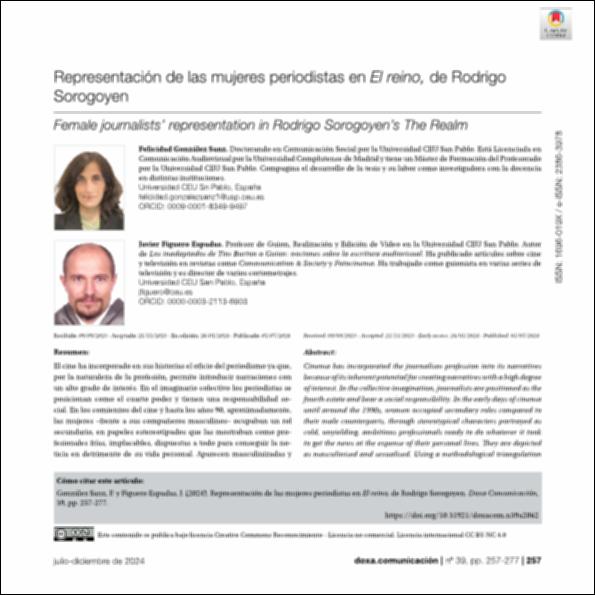Please use this identifier to cite or link to this item:
http://hdl.handle.net/10637/16088Representación de las mujeres periodistas en El reino, de Rodrigo Sorogoyen
| Title: | Representación de las mujeres periodistas en El reino, de Rodrigo Sorogoyen |
| Authors : | González Sanz, Felicidad Figuero Espadas, Javier |
| Keywords: | Mujeres; Estereotipos; El reino; Rodrigo Sorogoyen; Periodistas; Women; Stereotypes; The Realm; Journalists |
| Publisher: | Universidad CEU San Pablo |
| Citation: | Felicidad González Sanz; Javier Figuero Espadas. Representación de las mujeres periodistas en El reino de Rodrigo Sorogoyen. Doxa Comunicación. 39, 2024. |
| Abstract: | El cine ha incorporado en sus historias el oficio del periodismo ya que, por la naturaleza de la profesión, permite introducir narraciones con un alto grado de interés. En el imaginario colectivo los periodistas se posicionan como el cuarto poder y tienen una responsabilidad social. En los comienzos del cine y hasta los años 90, aproximadamente, las mujeres –frente a sus compañeros masculinos– ocupaban un rol secundario, en papeles estereotipados que las mostraban como profesionales frías, implacables, dispuestas a todo para conseguir la noticia en detrimento de su vida personal. Aparecen masculinizadas y sexualizadas. Empleando una triangulación metodológica que aplica las técnicas del análisis descriptivo, el análisis fílmico y la entrevista en profundidad se estudia el largometraje El reino, de Rodrigo Sorogoyen, para determinar cómo se representa la figura de la periodista en él. Tras el estudio de los resultados se observa que las periodistas en activo, en la actualidad, no se ven representadas por la visión de su profesión que ofrece El reino ni el cine en general. Esto se debe a que se siguen perpetuando ciertos estereotipos con los que se muestra en la gran pantalla el rol de la mujer periodista. Cinema has incorporated the journalism profession into its narratives because of its inherent potential for creating narratives with a high degree of interest. In the collective imagination, journalists are positioned as the fourth estate and bear a social responsibility. In the early days of cinema until around the 1990s, women occupied secondary roles compared to their male counterparts, through stereotypical characters portrayed as cold, unyielding, ambitious professionals ready to do whatever it took to get the news at the expense of their personal lives. They are depicted as masculinised and sexualised. Using a methodological triangulation that applies descriptive analysis techniques, film analysis and in-depth interviews, the feature film The Realm, by Rodrigo Sorogoyen is studied to determine how the figure of the female journalist is represented in it. After studying the results, it can be concluded that present-day female journalists do not find an accurate representation of their profession in The Realm or cinema in general. This discrepancy stems from the persistent perpetuation of certain stereotypes that influence how women journalists' role is portrayed on the big screen. |
| URI: | http://hdl.handle.net/10637/16088 |
| Rights : | http://creativecommons.org/licenses/by-nc-nd/4.0/deed.es |
| ISSN: | 2386-3978 |
| Issue Date: | 1-Jul-2024 |
| Center : | Universidad San Pablo-CEU |
| Appears in Collections: | Facultad de Humanidades y CC de la Comunicación |
Items in DSpace are protected by copyright, with all rights reserved, unless otherwise indicated.


